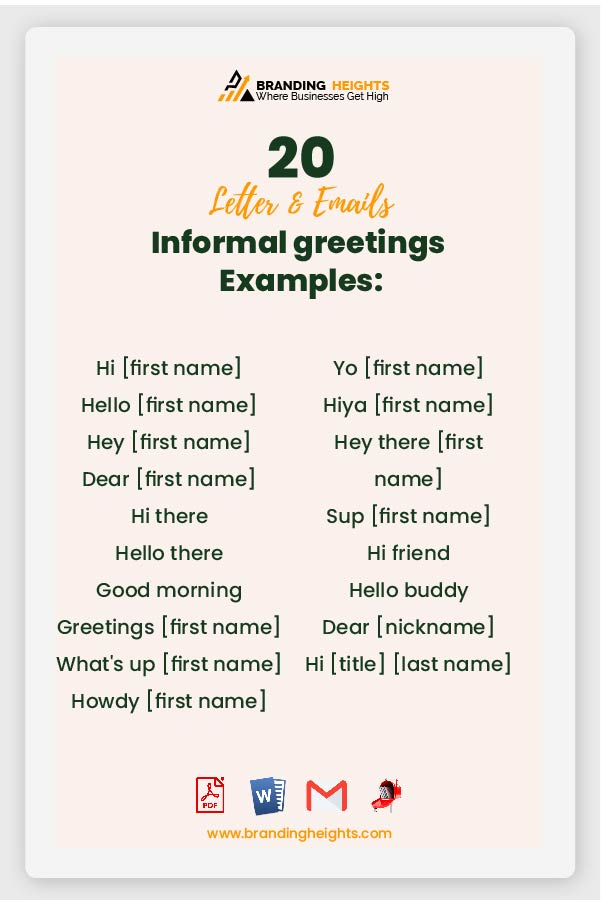A well-crafted letter can make all the difference in communication, and the importance of a good greeting cannot be overstated. The greeting is the first impression the reader gets of the letter’s tone and the writer’s personality. It sets the stage for what’s to come and can determine whether the reader will be engaged or disinterested. A good greeting can grab the reader’s attention, establish a connection, and pave the way for successful correspondence. Let’s start with How to Greet Like a Pro.
When writing a letter, it’s essential to choose the right greeting, as it can help create a positive relationship between the writer and the recipient. Whether it’s a formal letter or an informal one, a good greeting can set the tone for the entire message. The appropriate greeting can show respect, gratitude, friendliness, or professionalism, depending on the nature of the correspondence.
In this article, we will discuss 20 different ways to start a letter, ranging from formal to informal, and explain when to use each one. We hope these tips will help you create the perfect greeting for your next letter and set the right tone for the message you want to convey.
Different Types of Greetings For Letter
There are many types of greetings that can be used in letters, depending on the context and the relationship between the writer and the recipient. Here are some of the most common types of greetings:
- Formal greetings: These are used in professional or business letters, such as “Dear Sir/Madam” or “To Whom It May Concern.”
- Informal greetings: These are used in personal or friendly letters, such as “Hi” or “Hello.”
- Salutations: These are formal greetings that are used to address a specific person, such as “Dear Mr. Smith” or “Dear Dr. Jones.”
- Greetings for group letters: These are used when addressing a group of people, such as “Dear Members of the Board.”
- Seasonal greetings: These are used to convey holiday or seasonal wishes, such as “Merry Christmas” or “Happy New Year.”
- Greetings for thank-you letters: These are used to express gratitude, such as “Thank you for your help” or “Thank you for your time.”
- Greetings for sympathy letters: These are used to express condolences, such as “I am sorry for your loss” or “Please accept my heartfelt sympathies.”
- Greetings for congratulations letters: These are used to express congratulations, such as “Congratulations on your graduation” or “Congratulations on your promotion.”
Overall, the type of greeting used in a letter will depend on the purpose of the communication and the relationship between the writer and the recipient.
20 Formal Greetings Examples
Here are 20 formal greetings examples:
- Dear Sir/Madam
- To Whom It May Concern
- Dear Hiring Manager
- Dear Human Resources Manager
- Dear Admissions Committee
- Dear President/CEO
- Dear Board of Directors
- Dear Professor [last name]
- Dear Dean [last name]
- Dear Doctor [last name]
- Dear Reverend [last name]
- Dear Judge [last name]
- Dear Ambassador [last name]
- Dear Governor [last name]
- Dear Mayor [last name]
- Dear Supervisor [last name]
- Dear Director [last name]
- Dear Editor [last name]
- Dear Manager [last name]
- Dear Customer Service Representative
These formal greetings can be used in a variety of professional or business contexts, depending on the specific situation and relationship between the writer and the recipient.
20 Informal greetings Examples:
Here are 20 informal greeting examples:
- Hi [first name]
- Hello [first name]
- Hey [first name]
- Dear [first name]
- Hi there
- Hello there
- Good morning/afternoon/evening [first name]
- Greetings [first name]
- What’s up [first name]
- Howdy [first name]
- Yo [first name]
- Hiya [first name]
- Hey there [first name]
- Sup [first name]
- Hi friend
- Hello buddy
- Dear [nickname]
- Hi [title] [last name]
- Hello [title] [last name]
- Hey [title] [last name]
These informal greetings can be used in personal or friendly letters, or in situations where a more casual tone is appropriate. It’s important to consider the relationship between the writer and the recipient when selecting an informal greeting, as it may not be appropriate in all contexts.
20 Seasonal greetings Examples:
Here are 20 seasonal greeting examples:
- Merry Christmas
- Happy Hanukkah
- Happy Kwanzaa
- Happy Holidays
- Joyous Noel
- Season’s Greetings
- Happy New Year
- Feliz Navidad
- Happy Diwali
- Blessed Eid al-Fitr
- Happy Easter
- Happy Passover
- Happy Thanksgiving
- Happy Independence Day
- Happy Valentine’s Day
- Happy Halloween
- Happy St. Patrick’s Day
- Happy Labor Day
- Happy Memorial Day
- Happy Veterans Day
These seasonal greetings are appropriate for various holidays and occasions throughout the year. When sending a letter during a holiday season, it’s considerate to include a seasonal greeting to acknowledge the holiday or occasion and share good wishes with the recipient.
20 Greetings for sympathy letters:
Here are 20 greetings for sympathy letters:
- Dear [name of recipient]
- Dear [family member of deceased]
- To the [last name] family
- My dear friend
- Dear [name of friend who lost someone]
- My condolences
- I’m sorry for your loss
- With deepest sympathy
- Please accept my sincere condolences
- My heart goes out to you
- May peace and comfort find you during this difficult time
- I am here for you
- Thinking of you and your family
- Sending love and strength
- Wishing you peace and healing
- Our thoughts and prayers are with you
- Please know that we are thinking of you
- Our deepest condolences to you and your family
- We share your grief during this difficult time
- May fond memories of [name of deceased] bring you comfort and peace
These sympathy greetings are appropriate for expressing condolences and offering support to someone who has lost a loved one. When sending a sympathy letter, it’s important to show empathy and understanding and offer comfort and support to the recipient during their time of grief.
20 Greetings for congratulations letters:
Here are 20 greetings for congratulations letters:
- Congratulations!
- Way to go!
- Bravo!
- Good for you!
- You did it!
- Well done!
- Hooray!
- You deserve it!
- What an accomplishment!
- I’m so proud of you!
- Kudos!
- Hats off to you!
- Hip, hip, hooray!
- Outstanding!
- Fantastic!
- Impressive!
- Great job!
- Congratulations on a job well done!
- You rock!
- You’ve earned it!
These greetings are appropriate for congratulating someone on an achievement or success. Whether it’s a personal or professional accomplishment, it’s important to celebrate and acknowledge the hard work and dedication that went into achieving the goal. A congratulatory letter is a great way to show support and encouragement to someone who has reached a milestone or achieved something significant.
20 Greetings for thank-you letters:
Here are 20 greetings for thank-you letters:
- Dear [name]
- Dear [title] [last name]
- Dear [first name]
- Hello [name]
- Hi [name]
- Greetings [name]
- Good day [name]
- Warm greetings [name]
- Dear [name of team]
- To my dearest [name]
- My dear friend [name]
- Dear [title] [last name] and team
- To the wonderful [name]
- To my amazing [name]
- Dear valued [name]
- Hello dear [name]
- To my favorite [name]
- Hi there [name]
- Dear [nickname]
- To my [relationship]
These greetings are appropriate for expressing gratitude in a thank-you letter. When thanking someone, it’s important to show appreciation and acknowledge the specific actions or kindness that the recipient has shown. A well-written thank-you letter can help to strengthen relationships and show that you value the efforts and contributions of others.
Conclusion:
A good greeting in a letter is crucial as it sets the tone for the rest of the message and establishes a positive relationship between the writer and the recipient. The right greeting can show respect, friendliness, professionalism, or gratitude, depending on the context and purpose of the letter.
The article covers 20 different ways to start a letter, from formal to informal, and provides guidance on when to use each type of greeting. By trying out different greetings and personalizing them, readers can make their letters stand out and create a lasting impression on the recipient.
In conclusion, taking the time to craft a thoughtful greeting can make all the difference in a letter’s effectiveness. By considering the context, purpose, and relationship with the recipient, readers can choose the most appropriate greeting and make a positive impact from the very beginning.




